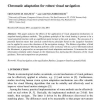Free Online Productivity Tools
i2Speak
i2Symbol
i2OCR
iTex2Img
iWeb2Print
iWeb2Shot
i2Type
iPdf2Split
iPdf2Merge
i2Bopomofo
i2Arabic
i2Style
i2Image
i2PDF
iLatex2Rtf
Sci2ools
AR
2002
2002
Chromatic adaptation for robust visual navigation
This paper analyzes the effects of the application of visual adaptation mechanisms on snapshot-based guidance methods. The guidance principle of the visual homing is proven to be a visual potential function with an equilibrium point located at the goal position. The presence of a potential function means that classical control theory principles based on the Lyapunov functions can be applied to assess the robustness of the navigation strategy. The Retinex algorithm, a blind chromatic equalizationpre- ltering that performs color constancy with no a priori information about the illuminant, is proposed as an unsupervised visual adaptation mechanism. It increases the visual information similarity under changes in the illuminant, thus increasing the robustness of the visual guidance. Tests and comparisons are presented.
| Added | 16 Dec 2010 |
| Updated | 16 Dec 2010 |
| Type | Journal |
| Year | 2002 |
| Where | AR |
| Authors | Giovanni M. Bianco, Alessandro Rizzi |
Comments (0)

